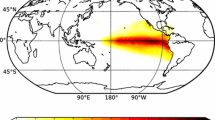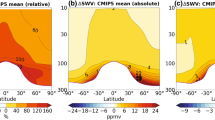Abstract
We assess the interactions between stratospheric water vapor (SWV) and surface temperature during the past two decades using satellite observations and the Community Earth System Model (CESM). From 1992 to 2013, to first order, the observed SWV exhibited three distinct piece-wise trends: a steady increase from 1992 to 2000, an abrupt drop from 2000 to 2004, and a gradual recovery after 2004, while the global-mean surface temperature experienced a strong increase until 2000 and a warming hiatus after 2000. The atmosphere-only CESM shows that the seasonal variation of tropical-mean (30°S–30°N) SWV is anticorrelated with that of the tropical-mean sea surface temperature (SST), while the correlation between the tropical SWV and SST anomalies on the interannual time scale is rather weak. By nudging the modeled SWV to prescribed profiles in coupled atmosphere-slab ocean experiments, we investigate the impact of SWV variations on surface temperature change. We find that a uniform 1 ppmv (0.5 ppmv) SWV increase (decrease) leads to an equilibrium global mean surface warming (cooling) of 0.12 ± 0.05 °C (−0.07 ± 0.05 °C). Sensitivity experiments show that the equilibrium response of global mean surface temperature to SWV perturbations over the extratropics is larger than that over the tropics. The observed sudden drop of SWV from 2000 to 2004 produces a global mean surface cooling of about −0.048 ± 0.041 °C, which suggests that a persistent change in SWV would make an imprint on long-term variations of global-mean surface temperature. A constant linear increase in SWV based on the satellite-observed rate of SWV change yields a global mean surface warming of 0.03 ± 0.01 °C/decade over a 50-year period, which accounts for about 19 % of the observed surface temperature increase prior to the warming hiatus. In the same experiment, trend analyses during different periods reveal a multi-year adjustment of surface temperature before the response to SWV forcing becomes strong relative to the internal variability in the model.











Similar content being viewed by others
References
Anderson J et al (2013) GOZCARDS merged data for water vapor monthly zonal means on a geodetic latitude and pressure grid V1.01 (GozMmlpH2O) at GES DISC, version 1.01, Greenbelt, MD, USA, NASA Goddard Earth Science Data and Information Services Center, Accessible at doi:10.5067/MEASURES/GOZCARDS/DATA3004
Booth BBB, Dunstone NJ, Halloran PR, Andrews T, Bellouin N (2012) Aerosols implicated as a prime driver of twentieth-century North Atlantic climate variability 484, 228. Nature 485:534. doi:10.1038/Nature11138
Castanheira JM, Peevey TR, Marques CAF, Olsen MA (2012) Relationships between Brewer–Dobson circulation, double tropopauses, ozone and stratospheric water vapour. Atmos Chem Phys 12:10195–10208. doi:10.5194/acp-12-10195-2012
Chen X, Tung K-K (2014) Varying planetary heat sink led to global-warming slowdown and acceleration. Science 345:897–903. doi:10.1126/science.1254937
Deser C, Phillips AS, Bourdette V, Teng H (2010) Uncertainty in climate change projections: the role of internal variability. Clim Dyn 38:527–546. doi:10.1007/s00382-010-0977-x
Dessler AE, Schoeberl MR, Wang T, Davis SM, Rosenlof KH (2013) Stratospheric water vapor feedback. Proc Natl Acad Sci USA 110:18087–18091. doi:10.1073/Pnas.1310344110
Dessler AE, Schoeberl MR, Wang T, Davis SM, Rosenlof KH, Vernier JP (2014) Variations of stratospheric water vapor over the past three decades. J Geophys Res Atmos 119:12588–512598. doi:10.1002/2014jd021712
England MH et al (2014) Recent intensification of wind-driven circulation in the Pacific and the ongoing warming hiatus. Nat Clim Change 4:222–227. doi:10.1038/NCLIMATE2106
Forster PMDF, Ponater M, Zhong W-Y (2001) Testing broadband radiation schemes for their ability to calculate the radiative forcing and temperature response to stratospheric water vapour and ozone changes. Meteorol Z 10:387–393. doi:10.1127/0941-2948/2001/0010-0387
Froidevaux L, Anderson J, Wang H-J, Fuller RA, Schwartz MJ, Santee ML, Livesey NJ, Pumphrey HC, Bernath PF, Russell JM III, McCormick MP (2015) Global ozone chemistry and related datasets for the stratosphere (GOZCARDS): methodology and sample results with a focus on HCl, H2O, and O3. Atmos Chem Phys 15:10471–10507. doi:10.5194/acp-15-10471-2015
Geoffroy O, Saint-Martin D, Olivie DJL, Voldoire A, Bellon G, Tyteca S (2013) Transient climate response in a two-layer energy-balance model. Part I: analytical solution and parameter calibration using AOGCM experiments. J Clim 26:1841–1857. doi:10.1175/Jcli-D-12-00195.1
Gilford DM, Solomon S, Portmann RW (2016) Radiative impacts of the 2011 abrupt drops in water vapor and ozone in the tropical tropopause layer. J Clim 29:595–612. doi:10.1175/JCLI-D-15-0167.1
Gregory J, Webb M (2008) Tropospheric adjustment induces a cloud component in CO2 forcing. J Clim 21:58–71. doi:10.1175/2007jcli1834.1
Hansen J, Sato M, Ruedy R (1997) Radiative forcing and climate response. J Geophys Res-Atmos 102:6831–6864. doi:10.1029/96jd03436
Hansen J, Ruedy R, Sato M, Lo K (2010) Global surface temperature change. Rev Geophys Artn. doi:10.1029/2010rg000345
Hegglin MI et al (2014) Vertical structure of stratospheric water vapour trends derived from merged satellite data. Nat Geosci 7:768–776. doi:10.1038/Ngeo2236
Held IM, Winton M, Takahashi K, Delworth T, Zeng FR, Vallis GK (2010) Probing the fast and slow components of global warming by returning abruptly to preindustrial forcing. J Clim 23:2418–2427. doi:10.1175/2009jcli3466.1
Huang Y (2013) On the longwave climate feedbacks. J Clim 26:7603–7610. doi:10.1175/Jcli-D-13-00025.1
Hurrell JW, Hack JJ, Shea D, Caron JM, Rosinski J (2008) A new sea surface temperature and sea ice boundary dataset for the Community Atmosphere Model. J Clim 21:5145–5153. doi:10.1175/2008jcli2292.1
Hurrell JW et al (2013) The community earth system model a framework for collaborative research. Bull Am Meteorol Soc 94:1339–1360. doi:10.1175/BAMS-D-12-00121.1
IPCC (2013) Climate change 2013: the physical science basis. Contribution of Working Group I to the Fifth Assessment Report of the Intergovernmental Panel on Climate Change. Cambridge University Press, Cambridge. doi:10.1017/CBO9781107415324
Jiang JH et al (2010) Five year (2004–2009) observations of upper tropospheric water vapor and cloud ice from MLS and comparisons with GEOS-5 analyses. J Geophys Res-Atmos 115:D15103. doi:10.1029/2009jd013256
Jiang JH et al (2012) Evaluation of cloud and water vapor simulations in CMIP5 climate models using NASA “A-Train” satellite observations. J Geophys Res-Atmos. doi:10.1029/2011jd017237
Jiang JH et al (2015) An assessment of upper-troposphere and lower-stratosphere water vapor in MERRA, MERRA2 and ECMWF reanalyses using Aura MLS observations. J Geophys Res-Atmos 120:11468–11485. doi:10.1002/2015JD023752
Kaufmann RK, Kauppi H, Mann ML, Stock JH (2011) Reconciling anthropogenic climate change with observed temperature 1998–2008. Proc Natl Acad Sci USA 108:11790–11793. doi:10.1073/Pnas.1102467108
Kosaka Y, Xie SP (2013) Recent global-warming hiatus tied to equatorial Pacific surface cooling. Nature 501:403–407. doi:10.1038/Nature12534
Liang CK, Eldering A, Gettelman A, Tian B, Wong S, Fetzer EJ, Liou KN (2011) Record of tropical interannual variability of temperature and water vapor from a combined AIRS-MLS data set. J Geophys Res. doi:10.1029/2010jd014841
Maycock AC, Shine KP (2012) Stratospheric water vapor and climate: sensitivity to the representation in radiation codes. J Geophys Res-Atmos 117:D13102. doi:10.1029/2012jd017484
Maycock AC, Joshi MM, Shine KP, Scaife AA (2013) The circulation response to idealized changes in stratospheric water vapor. J Clim 26:545–561. doi:10.1175/jcli-d-12-00155.1
Meehl GA, Collins WD, Boville BA, Kiehl JT, Wigley TML, Arblaster JM (2000) Response of the NCAR climate system model to increased CO2 and the role of physical processes. J Clim 13:1879–1898. doi:10.1175/1520-0442(2000)013<1879:Rotncs>2.0.Co;2
Meehl GA, Arblaster JM, Fasullo JT, Hu AX, Trenberth KE (2011) Model-based evidence of deep-ocean heat uptake during surface-temperature hiatus periods. Nat Clim Change 1:360–364. doi:10.1038/NCLIMATE1229
Morice CP, Kennedy JJ, Rayner NA, Jones PD (2012) Quantifying uncertainties in global and regional temperature change using an ensemble of observational estimates: the HadCRUT4 data set. J Geophys Res-Atmos. doi:10.1029/2011jd017187
Randel WJ, Wu F, Oltmans SJ, Rosenlof K, Nodoluha GE (2004) Interannual changes of stratospheric water vapor and correlations with tropical tropopause temperatures. J Atmos Sci 61:2133–2148
Randel WJ, Wu F, Vomel H, Nedoluha GE, Forster P (2006) Decreases in stratospheric water vapor after 2001: links to changes in the tropical tropopause and the Brewer–Dobson circulation. J Geophys Res-Atmos 111:D12312. doi:10.1029/2005jd006744
Reichler T, Dameris M, Sausen R (2003) Determining the tropopause height from gridded data. Geophys Res Lett 30:2042. doi:10.1029/2003gl018240
Richter JH, Solomon A, Bacmeister JT (2014) Effects of vertical resolution and nonorographic gravity wave drag on the simulated climate in the Community Atmosphere Model, version 5. J Adv Model Earth Syst 6:357–383. doi:10.1002/2013MS000303
Rosenlof KH, Reid GC (2008) Trends in the temperature and water vapor content of the tropical lower stratosphere: Sea surface connection. J Geophys Res-Atmos. doi:10.1029/2007jd009109
Rosenlof KH et al (2001) Stratospheric water vapor increases over the past half-century. Geophys Res Lett 28:1195–1198. doi:10.1029/2000gl012502
Soden BJ, Held IM (2006) An assessment of climate feedbacks in coupled ocean–atmosphere models. J Clim 19:3354–3360. doi:10.1175/Jcli3799.1
Solomon S, Rosenlof KH, Portmann RW, Daniel JS, Davis SM, Sanford TJ, Plattner GK (2010) Contributions of stratospheric water vapor to decadal changes in the rate of global warming. Science 327:1219–1223. doi:10.1126/Science.1182488
Su H, Waliser DE, Jiang JH, Li JL, Read WG, Waters JW, Tompkins AM (2006) Relationships of upper tropospheric water vapor, clouds and SST: MLS observations, ECMWF analyses and GCM simulations. Geophys Res Lett. doi:10.1029/2006gl027582
Takahashi H, Su H, Jiang JH (2015) Error analysis of upper tropospheric water vapor in CMIP5 models using “A-Train” satellite observations and reanalysis data. Clim Dyn. doi:10.1007/s00382-015-2732-9
Trenberth KE, Fasullo JT (2013) An apparent hiatus in global warming? Earth’s Future 1:19–32. doi:10.1002/2013ef000165
Urban J, Lossow S, Stiller G, Read WG (2014) Another drop in water vapor EOS. Trans Am Geophys Union 95:245–252
Wang Y, Jiang J, Su H (2015) Atmospheric responses to the redistribution of anthropogenic aerosols. J Geophys Res Atmos 120:9625–9641. doi:10.1002/2015JD023665
Watanabe M, Shiogama H, Tatebe H, Hayashi M, Ishii M, Kimoto M (2014) Contribution of natural decadal variability to global warming acceleration and hiatus. Nat Clim Change 4:893–897. doi:10.1038/NCLIMATE2355
Zhang K et al (2014) Technical note: on the use of nudging for aerosol–climate model intercomparison studies. Atmos Chem Phys 14:8631–8645. doi:10.5194/acp-14-8631-2014
Acknowledgments
The authors thank Prof. Susan Solomon for helpful discussions. We appreciate the funding support by Aura MLS project, NASA ROSES10-COUND, ROSES12-MAP, ROSES13-NDOA and ROSES13-AST programs. The research was carried out at the Jet Propulsion Laboratory, California Institute of Technology, under a contract with NASA. The description of Global Ozone Chemistry And Related trace gas Data records for the Stratosphere can be found at https://gozcards.jpl.nasa.gov/and the related data distribution is through http://mirador.gsfc.nasa.gov; the GOZCARDS project was funded by NASA under the MEaSUREs (Making Earth System Data Records for Use in Research Environments) program. The NCAR Community Earth System Model can be downloaded from http://www2.cesm.ucar.edu/. The surface temperature data from Climatic Research Unit can be obtained from http://www.cru.uea.ac.uk/cru/data/temperature/. The NASA GISS surface temperature data can be obtained at http://data.giss.nasa.gov/gistemp/.
Author information
Authors and Affiliations
Corresponding author
Rights and permissions
About this article
Cite this article
Wang, Y., Su, H., Jiang, J.H. et al. The linkage between stratospheric water vapor and surface temperature in an observation-constrained coupled general circulation model. Clim Dyn 48, 2671–2683 (2017). https://doi.org/10.1007/s00382-016-3231-3
Received:
Accepted:
Published:
Issue Date:
DOI: https://doi.org/10.1007/s00382-016-3231-3




